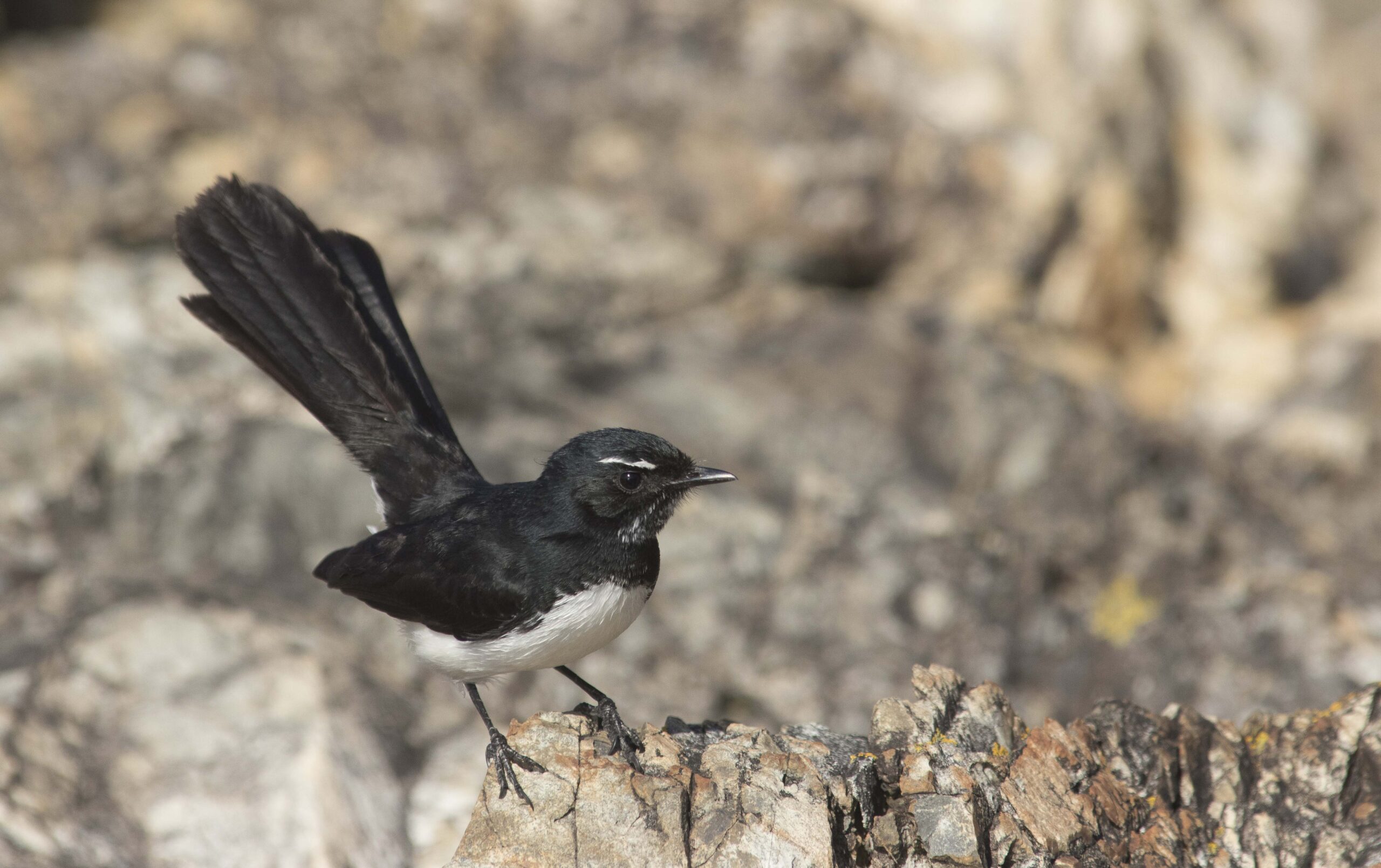Few birds are as widely recognised and loved in Australia as the Willie Wagtail (Rhipidura leucophrys). With its cheerful chattering, restless tail-wagging and fearless personality, this little bird seems to embody the spirit of the open country. It is as comfortable flitting about parks and gardens as it is darting across pastoral land and woodlands. For many, the Willie Wagtail is a daily companion, bold enough to challenge birds of prey, predatory reptiles and even humans when defending its nest.
Identification
The Willie Wagtail is a small passerine, measuring 19-21 cm in length. Its plumage is strikingly simple: glossy black upperparts, a white belly and a white eyebrow stripe that gives it an alert expression. Its most distinctive feature though, is its long, fanned tail, which it constantly flicks and wags from side to side. The bill is short and slightly flattened, adapted for catching insects on the wing. Its flight is fast and agile, often accompanied by an animated flurry of tail movements.
Habitat and Distribution
Rhipidura leucophrys is one of Australia’s most widespread birds, occurring across the mainland, Tasmania and extending to New Guinea, the Solomon Islands and parts of eastern Indonesia. It inhabits a wide variety of environments, including open woodlands, farmlands, grasslands, wetlands and urban areas. It is less common in dense rainforests and arid deserts but thrives anywhere with open spaces for foraging and trees or shrubs for nesting.
Ecological Role
As an insectivore, the Willie Wagtail plays a valuable role in controlling insect populations. It feeds primarily on flying insects such as flies, beetles and moths, which it captures mid-air in short, darting sallies from a perch. By reducing insect numbers, it contributes to ecological balance in both natural and human-modified landscapes. Its bold behaviour also influences bird interactions in its territory, as it often drives away much larger species.
Behaviour and Reproduction
The Willie Wagtail is active, inquisitive and highly territorial. Its constant tail-wagging is believed to flush insects from vegetation, making them easier to catch. Vocal and confident, it produces a range of chattering calls and musical phrases and in Aboriginal cultures, its vocalisations often feature in traditional stories and beliefs.
During the breeding season, which extends from August to January but may vary with rainfall, pairs build neat, cup-shaped nests from grass and spiderwebs, usually on horizontal branches. Clutches of 2-4 eggs are incubated by both parents. Willie Wagtails are fiercely protective of their nests, attacking raptors, kookaburras and even people who venture too close.
Conservation Status
The Willie Wagtail is listed as a species of Least Concern throughout Australia. It remains abundant and adaptable, thriving even in highly modified landscapes.
Threats
Because of its adaptability, the Willie Wagtail faces few major conservation threats. Predation of eggs and nestlings by larger birds, snakes and cats can affect local breeding success. Habitat clearing may reduce nesting opportunities in some regions, but overall the species has benefited from the creation of open landscapes.
Conservation Efforts
As a secure and widespread species, the Willie Wagtail does not require targeted conservation measures. It benefits from the protection of trees and shrubs in farmland and urban areas for nesting sites. Awareness campaigns around responsible pet ownership also indirectly support the species by reducing cat predation pressure.
Final Thoughts
The Willie Wagtail is a quintessential Australian bird – bold, adaptable and endlessly energetic. Its wagging tail and lively chatter bring life to both the bush and the backyard, making it a constant companion to people across the continent. Protecting Rhipidura leucophrys is less about saving a threatened species and more about celebrating the resilience of a bird that thrives alongside us, a reminder that even small creatures can have a big presence.
Fauna Resources specialises in the safe handling of a range of different fauna species, through safe, effective and ethical fauna solutions. By providing dedicated fauna services, through passionate fauna spotter catchers and fauna specialists, we can support the unique terrestrial ecosystems and rich biodiversity Australia has to offer.
For more information about our specialist fauna services, contact Fauna Resources today.
